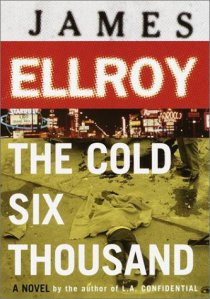 The Cold Six Thousand (2001) is the second part of James Ellroy’s Underworld USA trilogy. The trilogy covers American from the 50s to the early 70s, but it’s full of Ellroy’s bias that everybody is corruptible and that the mob rules all. The Cold Six Thousand kicks off right where the first book, American Tabloid (1995), left off with the assassination of President Kennedy. The first part of the novel concerns the cover-up that follows. Then we follow the next five years – Vietnam, Howard Hughes in Las Vegas, civil rights protests – ending with two big assassinations.
The Cold Six Thousand (2001) is the second part of James Ellroy’s Underworld USA trilogy. The trilogy covers American from the 50s to the early 70s, but it’s full of Ellroy’s bias that everybody is corruptible and that the mob rules all. The Cold Six Thousand kicks off right where the first book, American Tabloid (1995), left off with the assassination of President Kennedy. The first part of the novel concerns the cover-up that follows. Then we follow the next five years – Vietnam, Howard Hughes in Las Vegas, civil rights protests – ending with two big assassinations.
The three main characters are Ward J. Little, a former FBI man now mob lawyer; Pete Bondurant, something like a mercenary; and the new character Wayne Tedrow Jr. I was glad of a new main character because he was sympathetic and reluctant to kill, which is a big contrast to the rest of the cast of characters. But, no surprise, that doesn’t last long, soon he’s off torturing and cooking heroin.
The big thing to mention with The Cold Six Thousand is that Ellroy makes his sparse style even more minimalist. The tight, short, sharp sentences work well in American Tabloid, given the title it fits that the prose feels like headlines. But in The Cold Six Thousand Ellroy cuts the prose down the absolute minimum and, at times, seems like somebody parodying his style. After a few hundred pages the repetition becomes infuriating. The ‘simple’ style does not make the novel easier to follow, in fact it makes it harder, as Ellroy has several plot-threads and subplots on the go it becomes hard to untangle them and really understand what’s going on. By the end I felt like I was only vaguely aware of the choices the characters had made that led them to where the story ended.
I read this book quite soon after finishing the first one. I really liked American Tabloid, even though the characters did some dark things, and if you know Ellroy’s work you know how far he likes to push his characters. But what worked in American Tabloid was that it followed contrasting fall of one character and the rise of another. In The Cold Six Thousand a similar thing happened but the contrast never seemed as sharp as in the first book. In pretty much every aspect I did not like the second book as much as the first.
The style, lack of character development, and overly complicated plots make The Cold Six Thousand a very tough read and not a rewarding one. Perhaps if I get round the last part of the trilogy, Blood’s A Rover (2009) it’ll make the second part worthwhile, but right now I’m truly glad to be finished with The Cold Six Thousand and I think I need to take a long break before I pick up any James Ellroy again.
 David Goodis is an author I only heard about recently in the context that he is the forgotten great of noir fiction (and at the moment I can’t get enough noir). It took a while to get a copy of The Wounded and the Slain (1955) from the library, and all his other books have gone missing. But after reading the novel, do I think that Goodis is up there with Raymond Chandler and Dashiell Hammett? In short, I’d have to read another one of his novels to truly find out. While The Wounded and the Slain is not a bad novel, there were things about it I really disliked.
David Goodis is an author I only heard about recently in the context that he is the forgotten great of noir fiction (and at the moment I can’t get enough noir). It took a while to get a copy of The Wounded and the Slain (1955) from the library, and all his other books have gone missing. But after reading the novel, do I think that Goodis is up there with Raymond Chandler and Dashiell Hammett? In short, I’d have to read another one of his novels to truly find out. While The Wounded and the Slain is not a bad novel, there were things about it I really disliked.